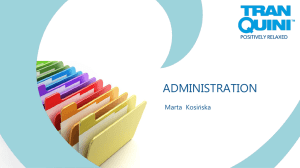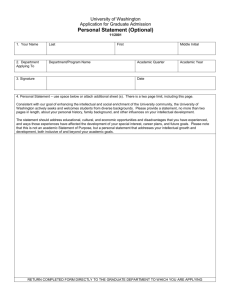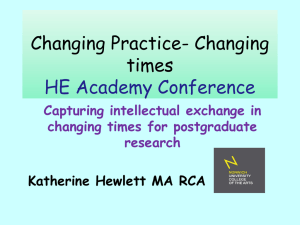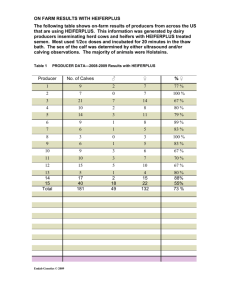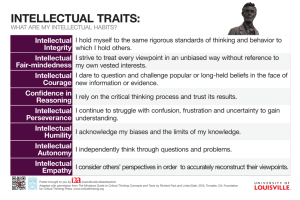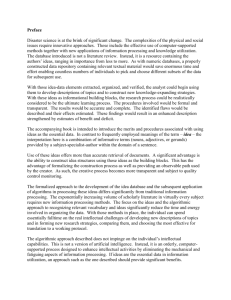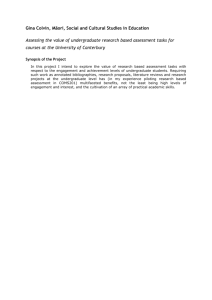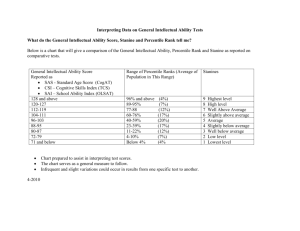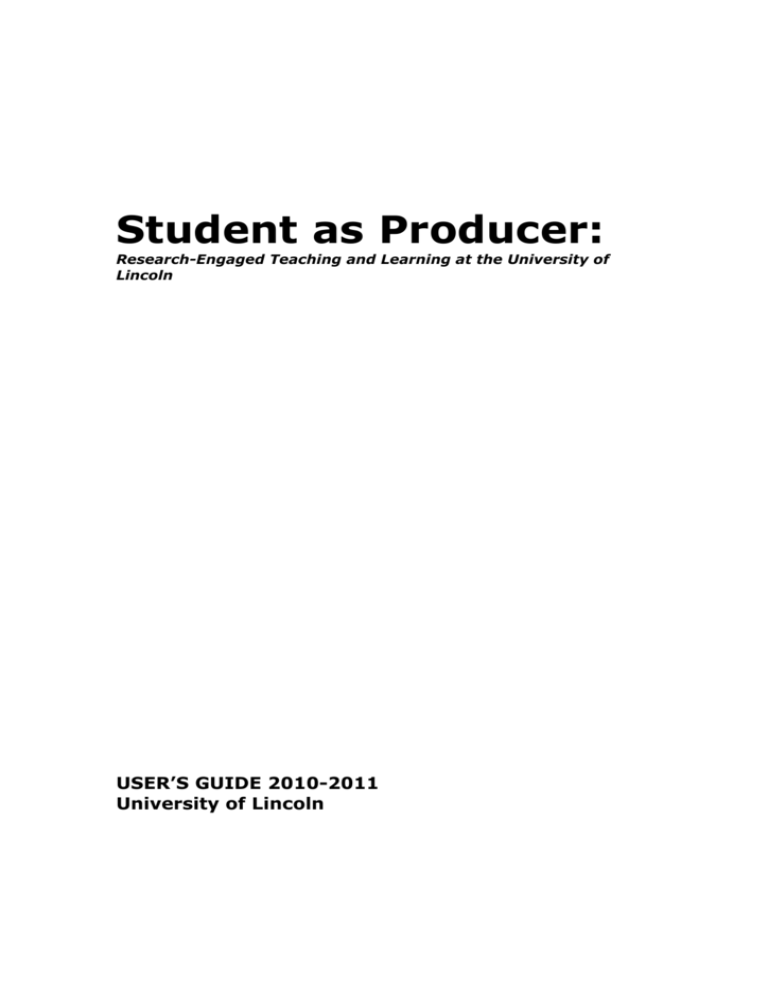
Student as Producer:
Research-Engaged Teaching and Learning at the University of
Lincoln
USER’S GUIDE 2010-2011
University of Lincoln
1
Contents
A New Type of University?
3
User’s Guide
4
Background
5
A Working Definition
6
Research into Research-engaged Teaching and Learning?
7
Why Research-Engaged Teaching and Learning at UL
9
Quality and Validation
10
Key features
Discovery - Student as Producer
Technology - Digital Scholarship
Space and Spatiality - Learning Landscapes
Assessment and Feedback – Active Learning in
Communities of Practice
o Research and Evaluation - Scholarship of
Teaching and Learning
o Student Voice: Diversity and Dissensus
o Creating the future: employability, enterprise, postgraduate,
Beyond Employability
o
o
o
o
Learning Outputs: innovation, creativity and uncertainty
15
Ongoing Development: working with staff and students
15
Open Access: Intellectual Property and Creative Commons
16
Implementation and Review
17
References
18
2
The University of Lincoln – a new type of university?
The idea to base teaching and learning at the University of Lincoln (UL) on the
principle and practices of research-engaged teaching is at an early stage of
development. This initiative has received enthusiastic support from staff and students
across the university, as well as some critical responses, as one would expect when
working in an academic environment. The point is not that everyone agrees with the
principle of research-engaged teaching, but that the university engages in an
intellectual discussion about the nature of teaching and learning and its relationship
to research at UL, in a progressive and collegiate manner. Research engaged
teaching and learning is not a template on which academics are being asked to base
their pedagogical activities, but a starting point to generate a fundamental debate
about how we teach at Lincoln.
Defining itself, and its relationship to teaching and learning and research in this way,
provides UL with the possibility of being able to distinguish itself in a manner that is
distinctive within the HE sector. While research-engaged teaching is prevalent in
higher education institutions, appearing in various forms across many subject areas,
there is no university that has taken this on as a unifying principle for its pedagogic
practices.
There is a certain amount of risk in this project, which means it is important to
proceed carefully and cautiously. We were very encouraged by the report from the
QAA visit in 2007-2008, which commended the work we were doing on this and
which encouraged the university to take the work further.
Research-engaged teaching is not new, but is grounded in the intellectual history and
tradition of the modern university. In a period when the meaning and purpose of
higher education is far from clear, some academics maintain that higher education is
being defined by government policy in ways that undermines the academic project.
The research engaged teaching and learning initiative is an attempt to restate the
purpose of higher education by seeking to reconnect the core activities of
universities, research and teaching, in a way that consolidates and substantiates the
values of academic life.
The core values of academic life are exemplified by the type of students that are
produced at UL. Student as Producer refers to the objects and resources and
processes that students create and invent, but it also refers to the ways in which
students are the creators of their own social world, as subjects rather than objects of
history (Benjamin 1934). This capacity for student subjectivity is found in the human
attributes of creativity and desire (Lefebvre 1991), so that students can recognise
themselves in a world of their own design (Debord 1970).
Professor Mike Neary
Dean of Teaching and Learning
3
A Users’ Guide
This document is a user’s guide to the practice and principles of
research-engaged teaching and learning at the University of Lincoln.
The document should be read as:
o
o
A guide to engaging with the concept of research-engaged teaching and
learning at UL
An aid to completing the validation and revalidation documentation required
by Quality, Standards and Partnerships at UL
Key to the concept of research engaged teaching at UL is how we define the concept
of users. For the purposes of this programme users are Academics, Professional and
Support Staff and Students.
Academics
Academics are responsible for the design and delivery of their own modules and
programmes. This is a key feature of teaching and learning in higher education. It is a
well established principle that modules and programmes should be informed by the
research and scholarship on which academics that create programmes and modules
are engaged. This principle of a research-rich curriculum is enhanced by researchengaged teaching. As well as being academically led, research engaged teaching
suggests that the process of teaching and learning can be considered in an
intellectual manner. This means designing teaching and learning activities that
connect knowledge and human interests through a theoretical engagement with
research, in a culture based on argumentation and critique (McLean 2006). In this
way, it is possible to, ‘deepen understanding of where problems might lie and what
do about them’, in a series of professional academic conversations grounded in the
principles of ‘solidarity, rationality and reflection’ (McLean 2006 109 and 125).
Professional and Support Staff
Key to the success of the implementation of research - engaged teaching at UL are
the ways in which professional and other support services are involved with the
Student as Producer programme. The emphasis within research-engaged teaching
implies much more emphasis on student choice, preference and self-management –
not only in the way that students are taught and learn, but also in the way that the
University communicates with students and administers them. In other words,
changing the learning and teaching culture has implications for the relationship with
students more generally.
Acknowledging and reconciling these implications is key to the success of the overall
approach – for example, the whole notion of learning anytime or anyplace is
undermined, if students are required to rely on traditional campus, and office hours,
focussed administrative support. The need for self-management has further
implications for Blackboard, which has potential to become a common launch point
(portal) for student self-management of both pedagogic and administrative functions,
which overlap in any case (e.g. through timetable, assessment, etc.). ICT
4
discussions with students indicate that they count both academic and support
services as part of their overall University experience(s) and expect consistency in
approach. In other words, while the University draws a distinction between academic
and support services, it seems that students do not.
Students
Students should be regarded as expert users of the university’s facilities and,
therefore, in a unique position to provide information and advice regarding the way in
which teaching and learning is developed at Lincoln. Student as Producer promotes
the involvement and engagement of students in the design and delivery of modules
and programmes. In this way UL will be applying the principles and practices
established elsewhere in the public sector for involving users of professional
services, e.g. social work, to improve provision (Crawford 2010).
.
Background
Research-engaged teaching and learning has been adopted at the University of
Lincoln (UL) as the pedagogical principle which informs teaching and learning and
research at the university. Staff and students are asked to engage with this principle,
intellectually as well as practically, in the design and delivery of the programmes at
the undergraduate level. The previous approach to connect research and teaching at
the university was research-informed teaching. The essential aspect of researchinformed teaching is that the content of lectures is dominated by the lecturer’s own
research interests, and information transmission is the main teaching mode. While a
research rich teaching environment is attractive to undergraduate students, there is
evidence that an information based teaching model, led by the transmission of a
researcher’s own intellectual interests, can exclude students from engaging fully in
the academic project of the university, leading to student alienation and
dissatisfaction (Zamorski 2002, Healey and Jenkins 2009).
Research-engaged teaching and learning is a further development of the best
aspects of research-informed teaching. The essential aspects of research-engaged
teaching and learning is that it involves a more research-oriented style of teaching,
where students learn about research processes, and where the curriculum
emphasises the ways by which knowledge is produced, rather than learning
knowledge that has already been discovered. It is important for research–based
teaching and learning that teaching is discipline specific, grounded in the intellectual
customs and traditions of a particular subject. In the academic literature this from of
pedagogical activity is described as a move from an instructional paradigm to a
learning paradigm (Barr and Tagg 1995).
The fundamental principle of research-engaged teaching is that the lecturer attempts
to create a research ethos throughout their teaching, from level one through to level
three – inside and outside of the curricula. In this way the curriculum is researchbased, where students learn as researchers, the curriculum is largely designed
around inquiry-based and problem solving activities, and the division of roles
between teacher and student is minimised (Brew 2006). While the division of roles is
minimised the authority of the teacher is maintained.
5
Research - engaged teaching and learning identifies what is essential about the
nature of teaching and learning in higher education, contributing to the debate about
the meaning and purpose of higher education: ‘the idea of the university’ (Delanty
2002, Mclean 2006). Research engaged - teaching finds its inspiration in the
intellectual and historical development of the modern European university, most
notably the liberal humanist university of Berlin of 1811 (Humboldt 1810) and the
radical university that emerged in May, 1968 (Neary and Hagyard 2010). The notion
of Student as Producer is designed as a form of intellectual and practical
engagement with the consumerist notion of undergraduate education that informs
government policy (Department for Business Innovation and Skills 2009).
The move to a research-based approach to teaching and learning reflects a
progressive development in the ways in which teaching and learning is now being
delivered in HE, both at UL and across the sector. While this form of teaching and
learning is becoming increasingly prevalent in universities, no one university has
sought to implement it across the whole of its teaching and learning provision. It is
this ambition to adopt research-engaged teaching and learning as the organising
principle for linking research and teaching across UL that is the really significant
aspect of this initiative.
A Working Definition
There is no prescribed model or template for research-engaged teaching and
learning at UL. The concept of research-engaged teaching and learning is offered as
an organisational principle around which teaching and learning activities can be
organised. Key to the development of this work is that research-engaged teaching
and learning is subject specific and based on the custom and traditions of each
particular discipline. However there is a layer of generic academic and information
handling skills which will be broadly common across disciplines.
While there is no template for research engaged teaching, central to any definition of
research-engaged teaching and learning is a shared understanding of the meaning of
the term ‘research’. The RAE (2008) definition of research can be used as a starting
point:
Research is to be understood as original investigation undertaken in order to gain
knowledge and understanding […].
However, for undergraduate research to be part of the mainstream curriculum it is
important to acknowledge that it is not always possible for research at the
undergraduate level to result in the production of new knowledge. However, it may be
that the discoveries that are made are new to the student, or new in a specific
learning context. What matters in certain research-engaged teaching and learning
situations is less the originality of the research outcome than the manner in which it is
acquired, i.e., in a way which is as close as possible to a genuine research
experience.
6
Therefore a definition of research-engaged teaching and learning might be:
‘A fundamental principle of curriculum design, where students learn primarily by
engagement in real research projects, or projects which replicate the process of
research in their discipline. Engagement is created through active collaboration
amongst and between students and academics, underpinned by the effective use of
information resources.’
This working definition will be adapted and worked on as UL builds up its own
substantive areas of expertise, and by working closely with other universities as
partners, as well as with schools and colleges for who research activity is becoming
and increasingly important part of the student experience.
Research on Research Engaged Teaching and Learning
Key to the practise of research-engaged teaching is the relationship between
teaching and learning and pedagogic research. Healey and Jenkins (2009) have
collected and collated a range of provision in the UK and internationally which points
to the effectiveness of linking teaching and research in the undergraduate curriculum.
This research includes:
‘Findings from several studies point to the positive influence of undergraduate
research programs on persistence and degree completion. ... Well-controlled studies
indicate that participation in research programs also elevates degree aspirations ...
and the likelihood of enrolling in graduate school’ (Pascarella and Terenzini 2005
406).
‘Comparison of the perspectives of faculty and their students revealed considerable
agreement on the nature, range, and extent of students’ undergraduate research
gains. Specific student gains relating to the process of “becoming a scientist” were
described and illustrated by both groups. Faculty framed these gains as part of
professional socialization into the sciences. In contrast, students emphasized their
personal and intellectual development’ (Hunter et al 2007 36).
‘There is growing evidence that – when done well – some programs and activities
appear to engage participants at levels that elevates their performance across
multiple engagement and desired outcomes measures such as persistence. ... They
include first-year seminars, common intellectual experiences, learning communities,
service learning, undergraduate research, study abroad and other experiences with
diversity, internships, and capstone courses and projects’ (Kuh 2008 14).
In other work, Creighton and John (2010) argue that research experiences for
undergraduates provide a rich opportunity for students to engage with a research
community, through which they can gain a sense of legitimate contribution to the
research process in HE, and an authentic research experience. Creighton and John
suggest that for these experiences to be effective they need to be well designed and
supported by academic staff, with room for students to develop their own judgement
and independence.
7
Levy (2010) draws attention to the possibilities for undergraduate participation in
knowledge building, as well as some of the problems. One of the difficulties is that
students may hold different ideas of what is meant by inquiry and research than their
teachers. In this case, Levy argues that it is important for teachers to move students
towards a connection with their own concepts of research so that undergraduates
can see themselves as student- researchers.
The QAA has expressed its interest in this area by commissioning work that sets out
the issues associated with research-engaged teaching for undergraduates (Taylor
and Wilding 2009).
8
Why Research - Engaged Teaching and Learning at Lincoln?
Reasons why Student as Producer is being introduced across the undergraduate
portfolio include:
o
It puts the student at the centre of the academic project of the university,
recognising and rewarding work of academic quality and content and value
o
Builds on work that is already ongoing, and so involves little organisational
disruption as a significant amount of the teaching and learning that takes
place at UL is already delivered in this way
o
Provides the opportunity for UL to rethink its resource allocation in terms of
teaching contact hours, while at the same time providing a high quality
student experience
o
Connects very directly with other institutional agendas at UL, including
strategic imperatives in relation to Teaching and Learning, Library and
Learning Development, Research and Enterprise; as well as connecting with
other specific initiatives including the Undergraduate Research Opportunities
Scheme and the Enterprise Research Opportunities Scheme, Neo - the
journal of student research, and ongoing work under the label of ‘Teaching in
Public’
o
Adds a coherent curriculum focus to the physical and virtual aspects of the
Learning Landscapes agenda
o
Links directly with plans in other faculties e.g. the Faculty of Business and
Law’s ‘Responsible Futures’ programme. ‘Responsible futures’ is defined as
reinforcing through discipline specific processes the idea that students are cocreators of knowledge in context of contemporary society for the public good.
Traditional teaching practices in Art, Architecture and Design are based on
the principles of collaborative teaching, and the participative pedagogies that
support studio learning are grounded in the practices that inform researchengaged teaching
o
Connects with ways in which students are already supporting how academics
teach and students learn, e.g., Peer Assisted Learning and the Students
Consulting on Teaching, as well as adding further substance to the ways in
which students are increasingly engaged with the quality agenda
o
Reinforces the link between teaching and research so as to enhance UL’s
reputation as a research intensive and teaching intensive university, while at
the same time giving the university a very distinctive profile within the sector.
9
Quality and Validation
The process of validation and revalidation is crucial to the successful implementation
of the Student as Producer programme. Research-engaged teaching and learning
will be introduced over a period of three to five years through the process of
validation and revalidation. Validation of programmes and modules is one of the key
points that staff and students will be asked to consider the extent to which their
pedagogical practice engages with research engaged teaching.
Quality is an issue that is high on the government agenda, with the process of
assuring quality in higher education under review. Student as Producer will give UL a
distinctive voice in debates about the relationship between quality assurance and
quality enhancement, with the notion of quality grounded in an organising principle
for teaching and learning at UL, as well as subject benchmark statements and other
quality descriptors. The relationship between assurance and enhancement will be
written into its quality documentation and validation of programme and module
processes.
The validation process requires that staff and students demonstrate the extent to
which the pedagogical activity on their programmes and modules reflect the key
features of research-engaged teaching. Student as Producer is not a template for
teaching, nor is it meant to be a prescriptive model, but staff and students are asked
to engage intellectually and practically with the concept of research-engaged
teaching and learning in the design and development of their programmes. Student
as Producer becomes the default position.
The validation process asks staff and students to consider Student as Producer in
terms of a number of key features.
The key features of Student as Producer are:
•
•
•
•
•
•
•
Discovery: Student as Producer
Technology in Teaching: Digital Scholarship
Space and Spatiality: Learning Landscapes in Higher Education
Assessment: Active Learners in Communities of Practice
Research and Evaluation: Scholarship of Teaching and Learning
Student Voice: Diversity, Difference and Dissensus
Support for research based learning through expert engagement with information
resources
• Creating the Future: Employability, Enterprise, Beyond Employability,
Postgraduate
Discovery: Student as Producer
The programme or module should be presented in a discovery mode, which in HE is
usually characterised as:
Problem - based learning (PBL)
A student-centered approach where students collaboratively solve problems and
reflect on their experiences. Characteristics of PBL are:
10
•
•
•
•
Learning is driven by challenging, open-ended problems
Students work in small collaborative groups
Teachers extend their role to becomes facilitators of learning
Students are encouraged to take responsibility for their group and organise and
direct the learning process with support from a tutor or instructor
• Library staff will provide support to ensure effective use of information resources
by students and staff
Enquiry - based learning (EBL)
EBL describes an environment in which learning is driven by a process of enquiry
owned by the student
• Starting with a ‘scenario’ and with the guidance of a facilitator, students identify
their own issues and questions
• Students examine the resources they need to research the topic, provided as part
of Learning Development@Lincoln, thereby acquiring the requisite knowledge.
Knowledge so gained is more readily retained because it has been acquired by
experience and in relation to a real problem.
Research - based learning (RBL)
Research-based learning is an approach to programme design and implementation
in which students have the opportunity to make intellectual and practical connections
between the content and skills that characterise their programmes, and the research
approaches and frontiers of the underlying disciplines. This includes:
• Systematic introduction of disciplinary related research into the course content
and teaching
• Inclusion of research methodology courses in the undergraduate program
• Design of learning activities based on authentic research problems in the public
domain that involve engagement with the wider community
• Access to support and instruction in the use of information resources.
Technology in Teaching: Digital Scholarship
Research engaged teaching implies a change in the relationship between tutor and
student. This changed relationship is facilitated by web 2, and is evident in various
web-based activities, for example, commons-based peer-production
http://en.wikipedia.org/wiki/Commons-based_peer_production, and Personal
Learning Environments based on user choice of available tools to complete
educational tasks http://zope.cetis.ac.uk/members/ple.
The changing relationship between tutor and student and the emergence of the
concept of Digital Scholarship can be facilitated by Web 2.0 technologies in that they
embed the following characteristics:
•
•
Identity – a way of uniquely identifying users in the system
Messaging – a synchronous way of communicating online in real time
11
•
•
•
Relationships – a way of describing how users within the system are related
to one another
Communities – a way of forming groups with a common interest
Reputation – a way of knowing the status other users in the system.
Tutors can demonstrate their use of technologies in teaching by the ways in which
they use Blackboard and other web-based technologies, as well as other methods of
enabling digitialised scholarship and collaboration between tutors and students.
These might include the use of online tutorials, and the embedding of information and
resource learning objects in the teaching process. Research - engaged teaching and
learning is not dependent on technology, but rather on the quality of the relationship
between student and teacher. In this context technology is regarded as an enabler
rather than an essential ingredient of the teaching and learning process, facilitating
an engaging intellectual relationship between students and staff (JISC 2009).
Space and spatiality: Learning Landscapes in HE
The use of space and spatiality in teaching is recognised as an important aspect of
the new learning landscape (Dugdale 2009, Neary et al 2010). In programme and
module planning, tutors can show how they intend to use space in their teaching
practice so as to:
•
•
•
•
•
Facilitate participation and collaboration
Engage with the community outside of the campus
Make use of formal and informal spaces
Ensure their teaching is accessible for students with diverse needs
Engage with spaces in the Library and elsewhere on and off campus to deliver
enhanced teaching experiences.
The use of both physical and virtual space is an important aspect of teaching, with
increased use of virtual space facilitated by Web 2.0, evolving VLE and increased
personalisation as outlined above. Use of IT in physical space is also more important
than ever in an environment where personal preference and collaboration are
paramount.
In particular, there is a heightened need to provide a robust and consistent IT
infrastructure and to provide support for student owned devices connected wirelessly.
Well-designed general access IT is also required with greater consideration given to
distribution and standards of IT services within the overall campus design. These
requirements drive review of desktop computer, audiovisual and print service
provision. (Kompen et al 2008)
Assessment and Feedback: Active Learning in Communities of Practice
Tutors should show the ways in which their assessments reflect the discovery mode
of teaching and learning, taking account of learning development support provided by
the Library, so as to provide students with the opportunity to demonstrate their
research skills, techniques, findings, outcomes and outputs.
12
The assessments should be designed to engage students so that they make sense
of academic assessment and marking criteria, and by involving them in the process
of designing assessment as well as in marking through peer assessment, group
assessment and self assessment, as well as feedback
(http://www.brookes.ac.uk/aske/matrix.).
Research-engaged teaching is inherently practice-based. Practice – based subjects
should demonstrate the ways in which research is incorporated into their assessment
criteria.
Research and Evaluation: Scholarship of Teaching and Learning
Evaluation of teaching practices includes student feedback, but can go beyond the
collection of feedback by involving staff and students in a programme of pedagogical
research into their own learning and teaching experiences.
A key aspect of research-engaged teaching is that it is informed by pedagogical
research into the effectiveness of this form of teaching and learning
(http://en.wikipedia.org/wiki/Scholarship_of_Teaching_and_Learning).
Tutors should demonstrate the way in which they intend to research their researchengaged teaching activities, based on research methods and methodologies.
Tutors should demonstrate the way in which this research will be disseminated
across UL and the sector so as to achieve maximum impact. This can include ways
in which this work can be used to apply for external funding.
Student Voice: Diversity, Difference and DIssensus
The issue of student leadership is becoming increasingly important in the HE sector .
The issue is related to the government’s intention to develop a new style of politics
and citizen engagement within which the student voice is not only heard, but
amplified (HEFCE 2009).
The emphasis on the Student Voice reflects the ways in which Student as Producer
is dedicated to developing a community of learners and teachers which is respectful
of diversity and difference, allowing for the space of dissensus and disagreement,
driven by engaged and participatory pedagogies (CLIP 2008).
Programmes should identify specific ways to amplify the student voice, and to
develop ways of working with students by giving them responsibility for the
management and delivery of their own learning. Programmes should also
demonstrate ways in which students might support the learning of other students.
Support for research- based teaching and learning through expert engagement with
information resources
13
Programmes should seek to engage with the University Library service to integrate
the development of skills in, and the use of information resources in their
programmes. Academic Subject Librarians are trained and equipped to work with
academics to support this process.
Creating the future: employability, enterprise, postgraduate, beyond
employability
Student as Producer retains a clear focus on the experience of students when they
leave the university. Student as Producer supports the career preparation and
aspirations of students, in the form of a traditional route into the professions, working
within an SME, creating a new start business, employment within the growing third
sector or going on to further study.
Student as Producer maintains that research-engaged teaching and learning is more
likely to result in graduates who are better prepared to cope with a globalised labour
market which is characterised by ever-changing technology and working practices
which include
¾ Project working
¾ Networking & collaboration
¾ Judged by results
¾ Distance working
¾ Less formal anything
¾ Enlist support rather than command & conquer
Forms of research engaged teaching, e.g., problem-based learning, are now widely
used in the teaching of professionals e.g., medicine and law. Curricula based on
research engaged teaching can be enriched by sourcing employers and work-based
projects for research activity.
Research engaged teaching can provide the skills and qualities that will be useful to
students when they leave the university to prepare them for a world of uncertainty
and complexity, where they need to find forms of existing that lie outside of the
traditional formats, and in ways that lie beyond what a mainstream education might
normally prepare them for ( Barnett 2001, Brew 2006).
Learning Outputs: Creativity, Originality and Uncertainty
14
The quality and validation process in higher education is based on the concept of
learning outcomes. Learning outcomes are defined as ‘descriptions of what the
learner is expected to learn in the period of learning defined and alongside this imply
the standard of learning expected’ (Gosling and Moon 200119). Based on the notion
of minimum threshold, learning outcomes prescribe what the student is expected to
be able to do by the end of a period of study, how they should be able to do this and
the level at which they must achieve this.
While learning outcomes have been an important aspect in providing a framework to
assure the quality of teaching and learning in higher education, there are limits to
their effectiveness and of their capacity to enhance teaching and learning in higher
education. Learning outcomes can become overly prescriptive, stifling creativity and
disempowering students and learners, undermining critical open ended notions of
student - centred learning (Ecclestone 1999, Hussey and Smith 2002).
Learning outputs build on learning outcomes by recognising the importance of
creativity and originality in student work. Learning outputs encourage students to
develop their own critical insights and understandings through interactions with
teachers. Learning outputs recognise the tensions and complexities: ‘ constructive
ambiguity’, of the learning environment ( Lampert 1985, Maher 2004, Biggs 1999,
Rust 2003).
Learning outputs might include research reports, published papers, designed objects
for exhibition, organisation of academic events, public performances etc. A key
aspect of learning output is that the nature of the output cannot be specified at the
outset of the programme, introducing a degree of creativity, originality and
uncertainty into the learning process.
Learning Outputs are closely linked to the attributes and attitudes, as well as the
possibilities and potentials that form the basis for enterprise-education at UL.
Access to and the development of the skills to critically evaluate, and build on the
work of others (from published and unpublished sources) will be an essential part of
this process.
Ongoing Developments: working with staff and students
Student as Producer provides the opportunity to highlight the very progressive
teaching practices that are taking place within the university that might already be
described as research - engaged teaching. An important aspect of the
implementation process of Student as Producer will be to review existing teaching
and learning provision programmes so as to gauge current research-engaged
teaching at UL and identify activities that already involve undergraduate students in
research and research-like activity, e.g., project work, independent learning modules,
forms of group work and dissertations.
15
Sharing best practice As a part of this ongoing development staff and students are
asked to post examples of best practice onto a dedicated UL website so as to share
ideas and inspirations with colleagues and other students
Valorisation Staff are asked to consider ways in which they might disseminate and
further valorise their research-engaged teaching and learning practices. This might
include research papers and publications, presentations at the UL Teaching and
Learning symposium etc.
Continuing Academic Development training and support for Student as Producer
will become and integral aspect of CPD at the university
Festival of Teaching and Learning UL will hold a celebration of teaching and
learning across the university and all of its campuses in 2010-2011. The theme of the
festival will be research-engaged teaching and learning
Networking UL is part of a network of universities, including staff and students, that
are engaged with the development of research-engaged teaching in their universities
and across the sector. These universities include Warwick, Reading, Oxford
Brookes, Gloucester, Leeds, UCLAN, Sheffield and Maastricht.
Open Access: Intellectual Property and the Creative
Commons
Open Access
Student as Producer:
•
•
Recognises the current exclusive rights of exploitation of intellectual property
for commercial purposes
Strongly promotes the use of Creative Commons licenses, as well as other
ways of making publically and openly accessible the intellectual products that
are developed at UL.
Intellectual Property
The Student as Producer programme places great emphasis on students creating an
object or product that has real academic content and value. This is very likely to raise
issues of ownership as well as the commercial exploitation of the object that is being
produced.
The current policy on intellectual property at UL requires that staff and students
benefit from any intellectual property they create. Research students assign
ownership and exploitation rights of their own intellectual property create to the
university on registration at the university. Taught undergraduates and postgraduates
are asked to assign their exclusive rights of ownership only if they are engaged on a
project that is likely to generate intellectual property.
16
Student as Producer supports the process of asking academic staff to give
consideration to intellectual property matters when engaging on collaborative
research projects with students, or when designing course work which has the
potential to create intellectual property. Students may, at any time, approach the
university with a view to seeking support for the commercialisation of intellectual
property belonging to them. This will generally involve the student assigning
ownership and exploitation rights to the university. The student should seek advice
and support from their supervisor or tutor in the first instance.
In exchange for the students signing away their exclusive rights the university
undertakes to treat students in the same ways as members of staff, i.e. as if they
were employees of the university. Where students are producers of intellectual
property they become fully engaged with the research project of the university.
Creative Commons
While the laws on intellectual property protect the rights of the producers by providing
income and enhanced reputation, the result is that fewer intellectual products are
available in the public domain. Academics have argued that the increasing use of
intellectual property law undermines the academic project by restricting the extent to
which academics can collaborate and learn from each others’ work (Fuller 2002).
The practice of Creative Commons has been established in law as a way of
increasing public access to intellectual property while maintaining copyright
protection. Creative Commons give producers of intellectual property a simple,
standardised way to grant copyright permissions to their creative work.
Creative Commons licenses help producers keep their copyright while allowing
certain uses of their work by other people. Creative Commons licenses are not an
alternative to copyright, but work alongside global copyright legislation so producers
can modify their copyright terms to best suit the needs of the producer. Creative
Commons defines the spectrum of possibilities between full copyright and the public
domain: from all rights reserved to no rights reserved.
Further information on how to make intellectual property openly and publically
available can be found at: http://creativecommons.org.
Implementation and Review
The current programme is being implemented through the Research-Engaged
Teaching and Learning Working Group, made up of staff and students from across
the university, reporting to the Teaching and Learning Committee. The working group
is chaired by Professor Mike Neary. If you have any questions with regard to
research-engaged teaching and learning at Lincoln you can contact Mike Neary at
mneary@lincoln.ac.uk, 01522 886015.
17
References
Barr, R. B and Tagg, J. (1995) ‘From Teaching to Learning: A New Paradigm for
Higher Education’, Change Magazine, 27 (6): 12 – 25
Biggs, J. (1999) Teaching for Quality Learning at University. Buckingham: Oxford
University Press.
Brew, A. (2006) Research and Teaching: Beyond the Divide, Palgrave Macmillan,
London
Crawford, K. (2010) Inter-professional Collaboration in Social Work, Sage, London
Creative Learning in Practice ( CLIP) ( 2008) Tell Us About It – Student Voices in
Creative Practice, University of the Arts, The Centre for Excellence in Teaching and
Learning, London
Creighton. J. and Creighton and John, J. (2010) ‘Becoming a Researcher:
Undergraduate Experiences in a Research Community of Practice’, Studies in Higher
Education ( under review)
Delanty, G. y, G (2001) Challenging Knowledge: The University in the Knowledge
Society, The Society for Research into Higher Education and Open University Press,
Buckingham and Philadelphia
Dugdale, S. (2009) Space Strategies for the New Learning Landscape Educause
Review, vol 44, no.2
Department for Business Innovation and Skills (2009) Higher Ambition The Future
of Universities in a Knowledge Economy - http://www.bis.gov.uk/policies/highereducation/shape-and-structure/higher-ambitions
Ecclestone, K. (1999) ‘Empowering or Ensnaring?: Outcome-based Assessment in
Higher Education’, Higher Education Quarterly 53(1), 29-48.
Gosling D & Moon J (2001)’ How to use Learning Outcomes and Assessment
Criteria’, SEEC
Healey , M. and Jenkins, A. (2009) Developing Undergraduate Research and
Enquiry, published by HEA
HEFCE ( 2009) Report to HEFCE on Student Engagement, Centre for Higher
Education Research and Information, The Open University
Humboldt, W. von (1970), ‘On the Spirit and Organisational Framework of Intellectual
Institutions in Berlin’, Minerva 8, pp. 242 – 267 [original 1810]
Hussey, T. and Smith, P. (2002) ‘The Trouble with Learning Outcomes’, Active
Learning in Higher Education 3(3), 220-233.
JISC ( 2009) Higher Education in a Web 2.0 World
http://www.jisc.ac.uk/publications/generalpublications/2009/heweb2.aspx
18
Kompen, R.T, Edirisingha, P, and Mobbs, R. (2008) Building Web 2.0-Based
Personal Learning Environments – A Conceptual Framework,EDEN Research
Workshop
Kuh , G.D. (2008) High Impact Activities: What they Are, Why They Work, Who
Benefits, in C. Rust (ed) Improving Student Learning Through the Curriculum, Oxford
Centre for Staff Learning and Development, Oxford Brookes University, Oxford
Lampert, M. (1985) ‘How Do Teachers Manage to Teach?’, Harvard Educational
Review 55, 181-185
Lefebvre, H. (1991) The Critique of Everyday Life, Volume 1, Verso,
London
Levy, P. (2010) ‘I Feel Like A Grown Up – First Year Undergraduate Experiences of
Inquiry and Research’ , Studies in Higher Education ( under review)
Maher, A. (2004) ‘Learning Outcomes in Higher Education: Implications for
Curriculum Design and Student Learning’ Journal of Hospitality, Leisure, Sport and
Tourism Education 3(2), 46-54.
http://www.heacademy.ac.uk/assets/hlst/documents/johlste/vol3no2/0078.pdf
M McLean, M. (2006) Pedagogy and the University, Continuum, London and New
York
Neary, M., Harrison, A., Saunders, G., Parekh, N., Crellin, G., and Austin, S. (2010)
Learning Landscapes in Higher Education, published by the Centre for Education
Research and Development, University of Lincoln
Neary, M. and Hagyard, A. (2010) ‘Pedagogy of Excess: An Alternative Political
Economy of Student Life’, in M Molesworth and L. Nixon, The Marketisation of Higher
Education – The Student as Consumer, Routledge, London
Rust, C., Price, M. and O’Donovan, B. (2003) ‘Improving Students’ Learning by
Developing their Understanding of Assessment Criteria and Processes’, Assessment
and Evaluation in Higher Education 28(2), 147-164.
Taylor, P and Wilding, D. (2009) ‘Rethinking the Values of Higher Education: the
Student as Collaborator and Producer – Undergraduate Research as a Case Study’,
published by the QAA
http://www.qaa.ac.uk/students/studentengagement/undergraduate.pdf
Zamorski, B. ( 2002) ‘Research-led Teaching and Learning in Higher Education: A
Case Study’, Teaching in Higher Education, 7 (4) 411-427
MN June 2010
19

